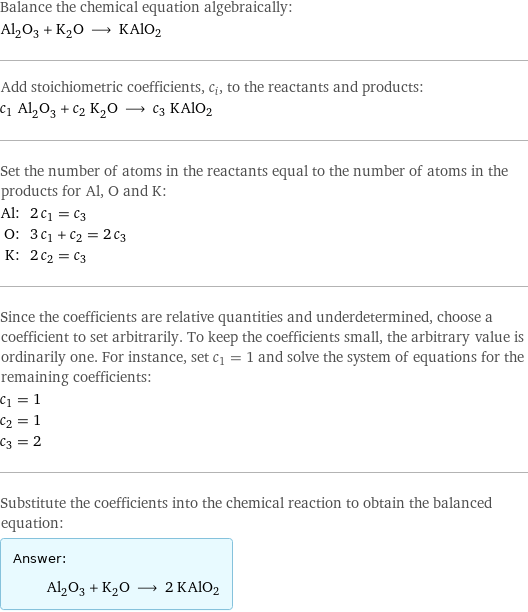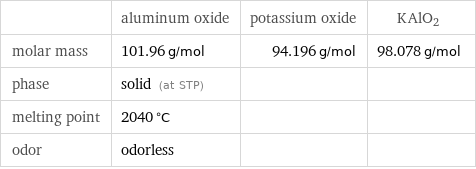Input interpretation

Al_2O_3 aluminum oxide + K_2O potassium oxide ⟶ KAlO2
Balanced equation

Balance the chemical equation algebraically: Al_2O_3 + K_2O ⟶ KAlO2 Add stoichiometric coefficients, c_i, to the reactants and products: c_1 Al_2O_3 + c_2 K_2O ⟶ c_3 KAlO2 Set the number of atoms in the reactants equal to the number of atoms in the products for Al, O and K: Al: | 2 c_1 = c_3 O: | 3 c_1 + c_2 = 2 c_3 K: | 2 c_2 = c_3 Since the coefficients are relative quantities and underdetermined, choose a coefficient to set arbitrarily. To keep the coefficients small, the arbitrary value is ordinarily one. For instance, set c_1 = 1 and solve the system of equations for the remaining coefficients: c_1 = 1 c_2 = 1 c_3 = 2 Substitute the coefficients into the chemical reaction to obtain the balanced equation: Answer: | | Al_2O_3 + K_2O ⟶ 2 KAlO2
Structures

+ ⟶ KAlO2
Names

aluminum oxide + potassium oxide ⟶ KAlO2
Equilibrium constant
![Construct the equilibrium constant, K, expression for: Al_2O_3 + K_2O ⟶ KAlO2 Plan: • Balance the chemical equation. • Determine the stoichiometric numbers. • Assemble the activity expression for each chemical species. • Use the activity expressions to build the equilibrium constant expression. Write the balanced chemical equation: Al_2O_3 + K_2O ⟶ 2 KAlO2 Assign stoichiometric numbers, ν_i, using the stoichiometric coefficients, c_i, from the balanced chemical equation in the following manner: ν_i = -c_i for reactants and ν_i = c_i for products: chemical species | c_i | ν_i Al_2O_3 | 1 | -1 K_2O | 1 | -1 KAlO2 | 2 | 2 Assemble the activity expressions accounting for the state of matter and ν_i: chemical species | c_i | ν_i | activity expression Al_2O_3 | 1 | -1 | ([Al2O3])^(-1) K_2O | 1 | -1 | ([K2O])^(-1) KAlO2 | 2 | 2 | ([KAlO2])^2 The equilibrium constant symbol in the concentration basis is: K_c Mulitply the activity expressions to arrive at the K_c expression: Answer: | | K_c = ([Al2O3])^(-1) ([K2O])^(-1) ([KAlO2])^2 = ([KAlO2])^2/([Al2O3] [K2O])](../image_source/4b91813e4bb97b7c1359784cfcaf48fe.png)
Construct the equilibrium constant, K, expression for: Al_2O_3 + K_2O ⟶ KAlO2 Plan: • Balance the chemical equation. • Determine the stoichiometric numbers. • Assemble the activity expression for each chemical species. • Use the activity expressions to build the equilibrium constant expression. Write the balanced chemical equation: Al_2O_3 + K_2O ⟶ 2 KAlO2 Assign stoichiometric numbers, ν_i, using the stoichiometric coefficients, c_i, from the balanced chemical equation in the following manner: ν_i = -c_i for reactants and ν_i = c_i for products: chemical species | c_i | ν_i Al_2O_3 | 1 | -1 K_2O | 1 | -1 KAlO2 | 2 | 2 Assemble the activity expressions accounting for the state of matter and ν_i: chemical species | c_i | ν_i | activity expression Al_2O_3 | 1 | -1 | ([Al2O3])^(-1) K_2O | 1 | -1 | ([K2O])^(-1) KAlO2 | 2 | 2 | ([KAlO2])^2 The equilibrium constant symbol in the concentration basis is: K_c Mulitply the activity expressions to arrive at the K_c expression: Answer: | | K_c = ([Al2O3])^(-1) ([K2O])^(-1) ([KAlO2])^2 = ([KAlO2])^2/([Al2O3] [K2O])
Rate of reaction
![Construct the rate of reaction expression for: Al_2O_3 + K_2O ⟶ KAlO2 Plan: • Balance the chemical equation. • Determine the stoichiometric numbers. • Assemble the rate term for each chemical species. • Write the rate of reaction expression. Write the balanced chemical equation: Al_2O_3 + K_2O ⟶ 2 KAlO2 Assign stoichiometric numbers, ν_i, using the stoichiometric coefficients, c_i, from the balanced chemical equation in the following manner: ν_i = -c_i for reactants and ν_i = c_i for products: chemical species | c_i | ν_i Al_2O_3 | 1 | -1 K_2O | 1 | -1 KAlO2 | 2 | 2 The rate term for each chemical species, B_i, is 1/ν_i(Δ[B_i])/(Δt) where [B_i] is the amount concentration and t is time: chemical species | c_i | ν_i | rate term Al_2O_3 | 1 | -1 | -(Δ[Al2O3])/(Δt) K_2O | 1 | -1 | -(Δ[K2O])/(Δt) KAlO2 | 2 | 2 | 1/2 (Δ[KAlO2])/(Δt) (for infinitesimal rate of change, replace Δ with d) Set the rate terms equal to each other to arrive at the rate expression: Answer: | | rate = -(Δ[Al2O3])/(Δt) = -(Δ[K2O])/(Δt) = 1/2 (Δ[KAlO2])/(Δt) (assuming constant volume and no accumulation of intermediates or side products)](../image_source/3a0390b7b203dbb6f21d4b220971f806.png)
Construct the rate of reaction expression for: Al_2O_3 + K_2O ⟶ KAlO2 Plan: • Balance the chemical equation. • Determine the stoichiometric numbers. • Assemble the rate term for each chemical species. • Write the rate of reaction expression. Write the balanced chemical equation: Al_2O_3 + K_2O ⟶ 2 KAlO2 Assign stoichiometric numbers, ν_i, using the stoichiometric coefficients, c_i, from the balanced chemical equation in the following manner: ν_i = -c_i for reactants and ν_i = c_i for products: chemical species | c_i | ν_i Al_2O_3 | 1 | -1 K_2O | 1 | -1 KAlO2 | 2 | 2 The rate term for each chemical species, B_i, is 1/ν_i(Δ[B_i])/(Δt) where [B_i] is the amount concentration and t is time: chemical species | c_i | ν_i | rate term Al_2O_3 | 1 | -1 | -(Δ[Al2O3])/(Δt) K_2O | 1 | -1 | -(Δ[K2O])/(Δt) KAlO2 | 2 | 2 | 1/2 (Δ[KAlO2])/(Δt) (for infinitesimal rate of change, replace Δ with d) Set the rate terms equal to each other to arrive at the rate expression: Answer: | | rate = -(Δ[Al2O3])/(Δt) = -(Δ[K2O])/(Δt) = 1/2 (Δ[KAlO2])/(Δt) (assuming constant volume and no accumulation of intermediates or side products)
Chemical names and formulas

| aluminum oxide | potassium oxide | KAlO2 formula | Al_2O_3 | K_2O | KAlO2 Hill formula | Al_2O_3 | K_2O | AlKO2 name | aluminum oxide | potassium oxide | IUPAC name | dialuminum;oxygen(2-) | dipotassium oxygen(2-) |
Substance properties

| aluminum oxide | potassium oxide | KAlO2 molar mass | 101.96 g/mol | 94.196 g/mol | 98.078 g/mol phase | solid (at STP) | | melting point | 2040 °C | | odor | odorless | |
Units
